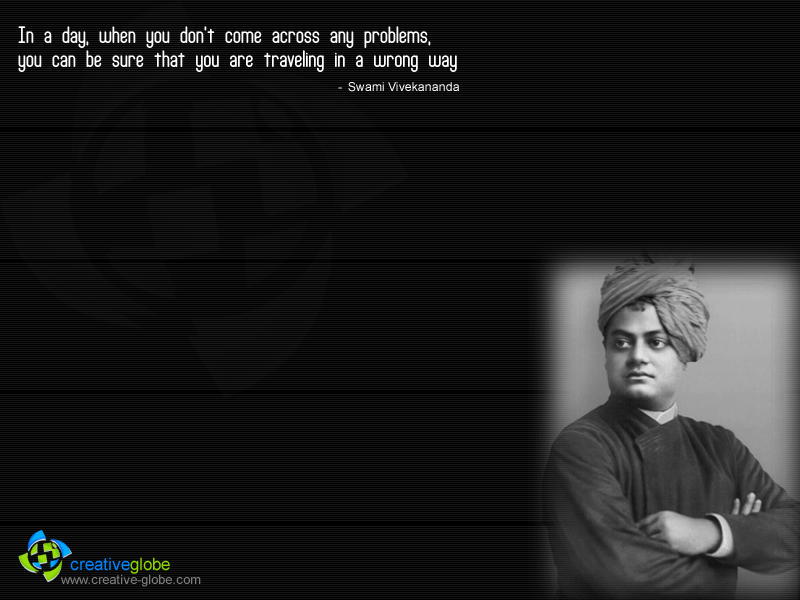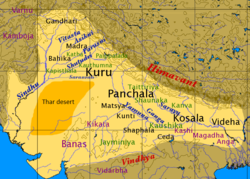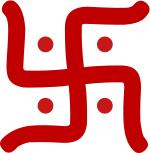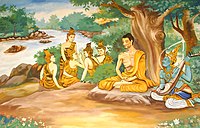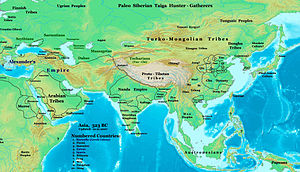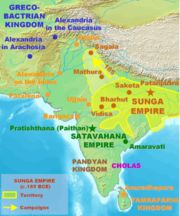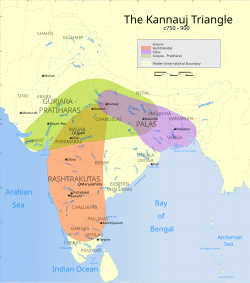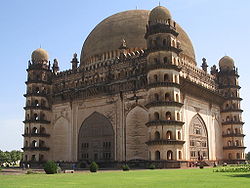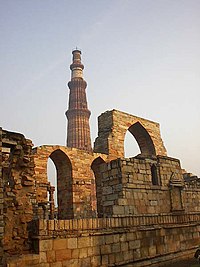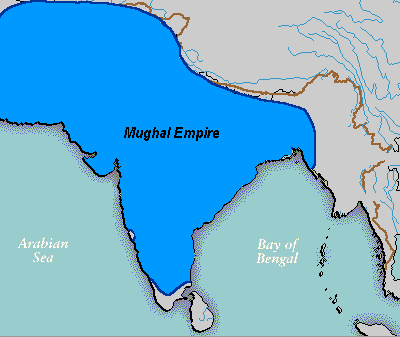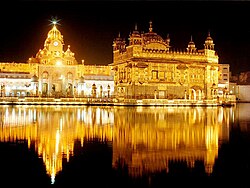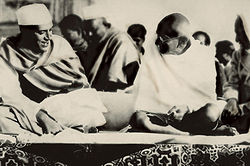| Swami Vivekananda | |
 Swami Vivekananda in Chicago, 1893 | |
| Date of Birth | 12 January 1863 |
|---|---|
| Place of birth | Calcutta, Bengal, India |
| Birth | Narendranath Dutta |
| Date of death | 4 July 1902 (aged 39) |
| Place of death | Belur Math near Kolkata |
| Guru/Teacher | Ramakrishna Paramahamsa |
| Quote | Arise, awake; and stop not till the goal is reached |
Swami Vivekananda(January 12, 1863–July 4, 1902), born Narendranath Dutta is the chief disciple of the 19th century mystic Ramakrishna and the founder of Ramakrishna Missin.Vivekananda is considered to be a major force in the revival of Hinduism in modern India.He is best known for his inspiring speech beginning with "sisters and brothers of America",through which he introduced Hinduism at the Parliament of the World's Religions at Chicago in 1893
Swami Vivekananda was born in an aristocratic Kayastha family of Calcutta in 1863. His parents influenced the Swami's thinking the father by his rational mind and the mother by her religious temperament. From his childhood, he showed inclination towards spirituality and God realization. While searching for a man who could directly demonstrate the reality of God, he came to Ramakrishna and became his disciple. As a guru Ramakrishna taught him Advaita Vedanta and that all religions are true, and service to man was the most effective worship of God. After the death of his Guru, he became a wandering monk touring the Indian subcontinent and getting a first hand account of India's condition. He later sailed to Chicago and represented India as a delegate in the 1893 Parliament of World religions. An eloquent speaker, Vivekananda was invited to several forums in United States and spoke at universities and clubs. He conducted several public and private lectures, disseminating Vedanta, Yoga and Hinduism in America, England and few other countries in Europe. He also established Vedanta societies in America and England. He later sailed back to India and in 1897 he founded the Ramakrishna Math and Mission, a philanthropic and spiritual organization. Swami Vivekananda is regarded as one of India's foremost nation-builders. His teachings influenced the thinking of other national leaders and philosophers, like Mahatma Gandhi, Jawaharlal Nehru, Subhas Chandra Bose, Aurobindo Ghosh, Radhakrishnan.
Biography
Birth and Childhood
Swami Vivekananda was born in Shimla Pally, Calcutta at 6:33 a.m on Monday, 12 January 1863, during the eve of Makra Sankranti festival and was given the name Narendranath Datta.His father Vishwanath Datta was an attorney of Calcutta High Court. He was considered generous, and had a progressive outlook in social and religious matters. His mother Bhuvaneshwari Devi was pious and had practiced austerities and prayed to Vireshwar Shiva of Varanasi to give her a son. She reportedly had a dream in which Shiva rose from his meditation and said that he would be born as her son.

Bhuvaneshwari Devi (1841-1911).
"I am indebted to my mother for the efflorescence of my knowledge."—Vivekananda
"I am indebted to my mother for the efflorescence of my knowledge."—Vivekananda
His thinking and personality were influenced by his parents the father by his rational mind and the mother by her religious temperament.During his early years he became familiar with Western philosophy and science, and refused to accept anything without rational proof and pragmatic test. Another part of his mind was drawn to the spiritual ideals of meditation and non-attachment.
Narendranath started his education at home, later he was admitted to Metropolitan Institution of Ishwar Chandra Vidyasagar in 1871 and in 1879 he passed the Entrance Examination.He had varied interests and a wide range of scholarship in philosophy, history, the social sciences, arts, literature, and other subjects.He evinced much interest in scriptural texts, Vedas, the Upanishads, Bhagavad Gita, Ramayana, Mahabharata and the Puranas. He was also well versed in classical music, both vocal and instrumental. Since boyhood, he took an active interest in physical exercise, sports, and other organizational activities.Even when he was young, he questioned the validity of superstitious customs and discrimination based on caste and religion.
Narendranath's mother played a very important role in his spiritual development. One of the sayings of his mother Narendra quoted often in his later years was, "Remain pure all your life; guard your own honor and never transgress the honor of others. Be very tranquil, but when necessary, harden your heart."He reportedly was adept in meditation. He reportedly would see a light while falling asleep and he reportedly had a vision of Buddha during his meditation.
College and Brahmo Samaj
Narendranath entered the first year Arts class of Presidency College, Calcutta in January 1880 and the next year he shifted to Scottish Church College, Calcutta. During the course, he studied western logic, western philosophy and history of European nations.In 1881 he passed the Fine Arts examination and in 1884 he passed the Bachelor of Arts.
According to his professors, student Narendranath was a prodigy. Dr. William Hastie, the principal of Scottish Church College, where he studied during 1881-84, wrote, "Narendra is really a genius. I have travelled far and wide but I have never come across a lad of his talents and possibilities, even in German universities, among philosophical students." After a discussion with Narendranath, Dr. Mahendralal Sarkar reportedly said, "I could never have thought that such a young boy had read so much!"
From his childhood, he showed inclination towards spirituality, God realisation and realizing the highest spiritual truths. He studied different religious and philosophical systems of East and the West; he met different religious leaders. He came under the influence of the Brahmo Samaj, an important socio-religious organization of that time. His initial beliefs were shaped by Brahmo Samaj, which believed in formless God, deprecated the worship of idols and devoted itself to socio-religious reforms.
His first introduction to Ramakrishna occurred in a literature class, when he heard Principal Hastie lecturing on William Wordsworth's poem The Excursion and the poet's nature-mysticism. In the course of explaining the word trance in the poem, Hastie told his students that if they wanted to know the real meaning of it, they should go to Ramakrishna of Dakshineswar. This prompted some of his students, including Narendranath to visit Ramakrishna
With Ramakrishna

Ramakrishna Paramahamsa
"The magic touch of the Master that day immediately brought a wonderful change over my mind. I was astounded to find that really there was nothing in the universe but God! … everything I saw appeared to be Brahman. … I realized that I must have had a glimpse of the Advaita state. Then it struck me that the words of the scriptures were not false. Thenceforth I could not deny the conclusions of the Advaita philosophy."
|
His meeting with Ramakrishna Paramahamsa in November 1881 proved to be a turning point in his life. About this meeting, Narendranath said, "He [Ramakrishna] looked just like an ordinary man, with nothing remarkable about him. He used the most simple language and I thought 'Can this man be a great teacher?'– I crept near to him and asked him the question which I had been asking others all my life: 'Do you believe in God, Sir?' 'Yes,' he replied. 'Can you prove it, Sir?' 'Yes.' 'How?' 'Because I see Him just as I see you here, only in a much intenser sense.' That impressed me at once. I began to go to that man, day after day, and I actually saw that religion could be given. One touch, one glance, can change a whole life.He even rejected the Advaitist Vedantism of identity with absolute as blasphemy and madness, and often made fun of the concept
Though Narendra could not accept Ramakrishna and his visions, he could not neglect him either. It had always been in Narendra's nature to test something thoroughly before he would accept it. He tested Ramakrishna, who never asked Narendra to abandon reason, and faced all of Narendra's arguments and examinations with patience ,"Try to see the truth from all angles" was his reply.During the course of five years of his training under Ramakrishna, Narendra was transformed from a restless, puzzled, impatient youth to a mature man who was ready to renounce everything for the sake of God-realization. In time, Narendra accepted Ramakrishna as guru, and when he accepted, his acceptance was whole-hearted and with complete surrendering as disciple.
In 1885 Ramakrishna suffered from throat cancer and he was shifted to Calcutta and later to Cossipore. Vivekananda and his brother disciples took care of Ramakrishna during this final days. His spiritual education under Ramakrishna continued here. At Cossipore, Vivekananda reportedly experienced Nirvikalpa Samadhi.During the last days of Ramakrishna, Vivekananda and some of the other disciples received the ochre monastic robes from Ramakrishna, which formed the first monastic order of Ramakrishna.Vivekananda was taught that service to men was the most effective worship of God. It is reported that when Vivekananda, doubted Ramakrishna's claim of avatara, Ramakrishna reportedly said, "He who was Rama, He who was Krishna, He himself is now Ramakrishna in this body."During his final days, Ramakrishna asked Vivekananda to take care of other monastic disciples and in turn asked them to look upon Vivekananda as their leader.Ramakrishna's condition worsened gradually and he expired in the early morning hours of August 16, 1886 at the Cossipore garden house. According to his disciples, this was Mahasamadhi.
Baranagore Monastery
After the death of their master, the monastic disciples led by Vivekananda formed a fellowship at a half-ruined house at Baranagar near the river Ganga, with the financial assistance of the householder disciples. This became the first Math or monastery of the disciples who constituted the first Ramakrishna Order.
The dilapidated house at Baranagore was chosen because of its low rent and proximity to the Cossipore burning-ghat, where Ramakrishna was cremated. Narendra and other members of the Math often spent their time in meditation, discussing about different philosophies and teachings of spiritual teachers including Ramakrishna, Shankaracharya, Ramanuja, and Jesus Christ.Narendra reminisced about the early days in the monastery as follows, "We underwent a lot of religious practice at Baranagore Math. We used to get up at 3:00 am and become absorbed in japam and meditation. What a strong spirit of dispassion we had in those days! We had no thought even as to whether the world existed or not"In the early part of 1887, Narendra and eight other disciples took formal monastic vows. Narendra took the name of Swami Vividishananda.
Parivrâjaka — Wandering monk

Swami Vivekananda's first photo as a Wandering monk at Jaipur.
In 1888, Vivekananda left the monastery as a Parivrâjaka the Hindu religious life of a wandering monk, "without fixed abode, without ties, independent and strangers wherever they go." His sole possessions were a kamandalu (water pot), staff, and his two favorite books—Bhagavad Gita and The Imitation of Christ.Narendranath travelled the length and breadth of India for five years, visiting important centers of learning, acquainting himself with the diverse religious traditions and different patterns of social life.He developed a sympathy for the suffering and poverty of the masses and resolved to uplift the nation.Living mainly on Bhiksha or alms, Narendranath traveled mostly on foot and railway tickets bought by his admirers whom he met during the travels. During these travels he gained acquaintance and stayed with scholars, Dewans, Rajas and people from all walks of life Hindus, Muslims, Christians, Pariahs (low caste workers), Government officials.
Northern India
In 1888, he started his journey from Varanasi. At Varanasi, he met pandit and Bengali writer, Bhudev Mukhopadhyay and Trailanga Swami, a famous saint who lived in a Shiva temple. Here, he also met Babu Pramadadas Mitra, the noted Sanskrit scholar, to whom the Swami wrote a number of letters asking his advice on the interpretation of the Hindu scriptures. After Varanasi he visited Ayodhya, Lucknow, Agra, Vrindaban, Hathras and Rishikesh. At Hathras he met Sharat Chandra Gupta, the station master who later became one of his earliest disciples as Sadananda. Between 1888-1890, he visited Vaidyanath, Allahabad. From Allahabad, he visited Ghazipur where he met Pavhari Baba, a Advaita Vedanta ascetic who spent most of his time spent in meditation.
The Himalayas
In July 1890,he visited, Nainital, Almora, Srinagar, Dehra Dun, Rishikesh, Hardwar and the Himalayas. During this travel, he reportedly had a vision of macrocosm and microcosm, which seems to be reflected in the Jnana Yoga lectures he gave later in the West, "The Cosmos—The Macrocosm and The Microcosm".
Southern India
At Bangalore, the Swami became acquainted with Sir K. Seshadri Iyer, the Dewan of Mysore state, and later he stayed at the palace as guest of the Maharaja of Mysore, Shri Chamarajendra Wadiyar. Regarding Swami's learning, Sir Seshadri reportedly remarked, "a magnetic personality and a divine force which were destined to leave their mark on the history of his country." The Maharaja provided the Swami a letter of introduction to the Dewan of Cochin and got him a railway ticket.

Vivekananda Temple on Vivekananda rock at Kanyakumari, India
From Bangalore, he visited Trichur, Kodungalloor, Ernakulam. At Ernakulam, he met Chattampi Swamikal, the guru of Narayana Guru in early December 1892.From Ernakulam, he journeyed to Trivandrum, Nagercoil and reached Kanyakumari on foot during the Christmas Eve of 1892.At Kanyakumari, the Swami reportedly meditated on the "last bit of Indian rock", famously known later as the Vivekananda Rock Memorial for three days.At Kanyakumari, Vivekananda reportedly had the "Vision of one India". He wrote,
First visit to the West
His journey to America took him through China, Japan, Canada and he arrived at Chicago in July 1893.But to his disappointment he learnt that no one without credentials from a bona fide organization would be accepted as a delegate. He came in contact with Professor John Henry Wright of Harvard University.After inviting him to speak at Harvard and on learning of his not having credential to speak at the Parliament, Wright is quoted as having said, "To ask for your credentials is like asking the sun to state its right to shine in the heavens." Wright then addressed a letter to the Chairman in charge of delegates writing, "Here is a man who is more learned than all of our learned professors put together." On the Professor Vivekananda himself writes, "He urged upon me the necessity of going to the Parliament of Religions, which he thought would give an introduction to the nation."
Parliament of World's Religions

Swami Vivekananda on the Platform of the Parliament of Religions
The Parliament of Religions opened on 11 September 1893 at the Art Institute of Chicago. On this day Vivekananda gave his first brief address. He represented India and Hinduism.Though initially nervous, he bowed to Saraswati, the goddess of learning and began his speech with, "Sisters and brothers of America!".To these words he got a standing ovation from a crowd of seven thousand, which lasted for two minutes. When silence was restored he began his address. He greeted the youngest of the nations in the name of "the most ancient order of monks in the world, the Vedic order of sannyasins, a religion which has taught the world both tolerance and universal acceptance."And he quoted two illustrative passages in this relation, from the Bhagavad Gita. "As the different streams having their sources in different places all mingle their water in the sea, so, O Lord, the different paths which men take, through different tendencies, various though they appear, crooked or straight, all lead to Thee!" and "Whosoever comes to Me, through whatsoever form, I reach him; all men are struggling through paths that in the end lead to Me."
Back in India
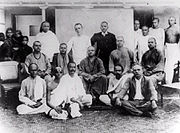
Swami Vivekananda at Chennai 1897
Colombo to Almora
Vivekananda arrived in Colombo on January 15, 1897 and received a grand welcome. Here, he gave his first public speech in East, India, the Holy Land. From there on, his journey to Calcutta was a triumphal progress. He traveled from Colombo to Pamban, Rameshwaram, Ramnad, Madurai, Kumbakonam and Madras delivering lectures. People and Rajas gave him enthusiastic reception. In the procession at Pamban, the Raja of Ramnad personally drew the Swami's carriage. On way to Madras, at several places where the train would not stop, the people squatted on the rails and allowed the train to pass only after hearing the Swami. From Madras, he continued his journey to Calcutta and continued his lectures up to Almora.
Founding of Ramakrishna Math and Mission

Advaita Ashrama, Mayavati, a branch of the Ramakrishna Math, founded on March 19, 1899, later published many of Swami Vivekanada's work, now publishes Prabuddha Bharata journal
On 1 May 1897 at Calcutta, Vivekananda founded the "Ramakrishna Math" the organ for propagating religion and "Ramakrishna Mission" the organ for social service.This was the beginning of an organized socio-religious movement to help the masses through educational, cultural, medical and relief work. The ideals of the Ramakrishna Mission are based on Karma Yoga.] Two monasteries were founded by him, one at Belur, near Calcutta, which became the Headquarters of Ramakrishna Math and Mission and the other at Mayavati on the Himalayas, near Almora called the Advaita Ashrama.
Last years

The Swami Vivekananda temple at Belur Math, on the place where he was cremated.
Vivekananda spent few of his days at Advaita Ashrama, Mayavati and later at the Belur Math. In December 1901, he was invited to Japan to participate in the Congress of Religions, however his failing health made it impossible. He undertook pilgrimages to Bodhgaya and Varanasi towards his final days.
His tours, hectic lecturing engagements, private discussions and correspondence had taken their toll on his health. He was suffering from Asthma, diabetes and other physical ailments.Few days prior to his demise, he was seen intently studying the almanac. Three days before his death he pointed out the spot for this cremation—the one at which a temple in his memory stands today. He had remarked to several persons that he would not live to be forty.
On the day of his death, he taught Shukla-Yajur-Veda to some pupils in the morning at Belur Math.He had a walk with Swami Premananda, a brother-disciple, and gave him instructions concerning the future of the Ramakrishna Math. Vivekananda expired at ten minutes past nine on July 4, 1902 while he was meditating. According to his disciples, this was Mahasamadhi.Afterward, his disciples recorded that they had noticed "a little blood" in the Swami's nostrils, about his mouth and in his eyes.The doctors remarked that it was due to the rupture of a blood-vessel in the brain, but they could not find the real cause of the death. According to his disciples, Brahmarandhra— the aperture in the crown of the head must have been pierced when he attained Mahasamadhi. Vivekananda had fulfilled his own prophecy of not living to be forty-years old.

Vivekananda Rock Memorial by the night, Kanyakumari, Tamil Nadu
Influence
Several leaders of 20th Century India and philosophers have acknowledged Vivekananda's influence. The first governor general of independent India, Chakravarti Rajagopalachari, once observed that "Vivekananda saved Hinduism, saved India."According to Subhas Chandra Bose, Vivekananda "is the maker of modern India" and for Mohandas Gandhi, Vivekananda's influence increased his "love for his country a thousandfold." National Youth Day in India is held on his birthday, January 12, to commemorate him. This was a most fitting gesture as much of Swami Vivekananda's writings concerned the Indian youth and how they should strive to uphold their ancient values whilst fully participating in the modern world.
Swami Vivekananda is widely considered to have inspired India's freedom struggle movement. His writings inspired a whole generation of freedom fighters including Aurobindo Ghose and Bagha Jatin. Vivekananda was the brother of the extremist revolutionary, Bhupendranath Dutta. Subhash Chandra Bose one of the most prominent figures in Indian independence movement said.
Swami Vivekananda's ideas have had a great influence on the Indian youth. In many institutes, students have come together and formed organizations meant for promoting discussion of spiritual ideas and the practice of such high principles. Many of such organizations have adopted the name Vivekananda Study Circle. One such group also exists at IIT Madras and is popularly known as (VSC). Additionally, Swami Vivekananda's ideas and teachings have carried on globally, being practiced in institutions all over the world.
Mahatma Gandhi said, "Swami Vivekananda's writings need no introduction from anybody. They make their own irresistible appeal." At the Belur Math, Gandhi was heard to say that his whole life was an effort to bring into actions the ideas of Vivekananda. Many years after Vivekananda's death, Rabindranath Tagore a Nobel Poet Laureate had said, "If you want to know India, study Vivekananda. In him everything is positive and nothing negative."


